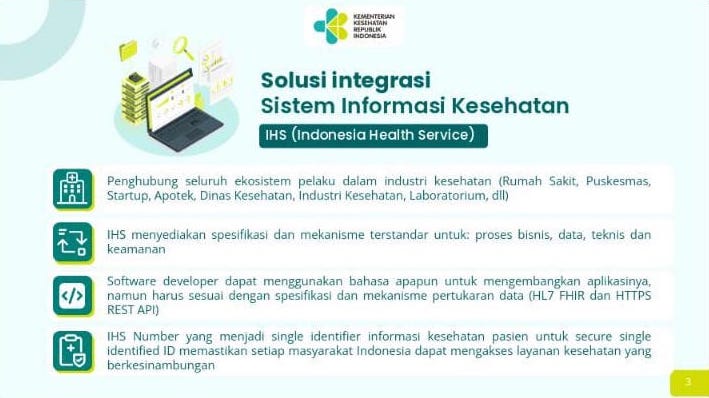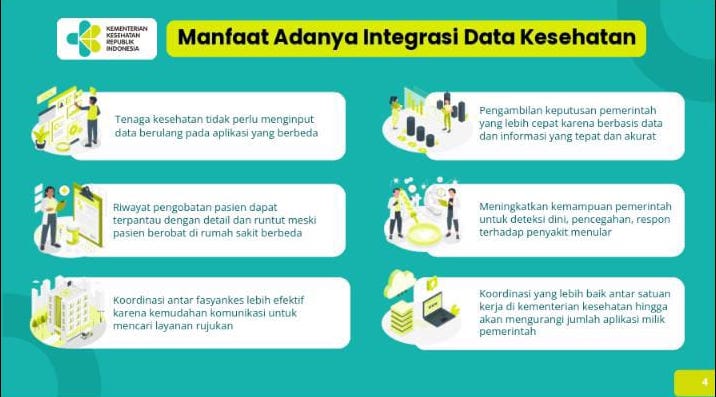Setiaji: Standardization Becomes the "Backbone" of Data Connectivity in the Health Industry
DailySocial exclusive interview with the Chief Digital Transformation Office (DTO) of the Ministry of Health Setiaji
Last year, while serving as the Minister's Expert Staff in the field of health technology, Setiaji received a mandate from the Minister of Health Budi Gunadi Sadikin to handle the pandemic and make the Covid-19 vaccination program a success with technology, as well as carry out digital transformation in the healthcare industry.
He is trusted to lead a major initiative--and perhaps the first time in the healthcare industry--through the Digital Transformation Office (DTO) to address a series of systemic problems in the country. Armed with his previous strong experience in bureaucracy and technology, Setiaji started his execution by compiling standardization of data as the backbone of the entire health ecosystem.
"Of course, the initial focus is how to deal with Covid-19 because the challenge is that every day around 400-500 people die. For me [becoming Chief DTO] is a noble task to reduce the death rate and spread of Covid-19 by involving technology," he said.
How was your initial preparation in leading a DTO?
Answer: At that time, the existing system, way of working and team did not support it. [The execution] cannot possibly be handled by an internal team because there are limited human resources, competencies, skill set, and experience to handle large systems. The vision and mission already exist, we just need to know how to accelerate it with a more effective and targeted team root cause-New.
I brought my experience to DTO, simplifying application systems and building teams to work more effectively. I previously had experience in forming startups within the government sector, namely in Jakarta (Head of Jakarta Smart City) and West Java (Head of ICT Digital Services). Well, there isn't one at the national level yet.
Our team then compiled roadmap, starting from what the direction is like and what the architecture is like. Of course the challenges will be huge because we are planning The roadmap while dealing with Covid-19. The term 'we ran while tying our shoelaces'.
Us set-up organization, structure, and talent. In the regions, this [organization] is attached to the Communication and Information Service as a PT, then there will be a govtech team. In the Ministry, the term is like Pusdatin (Data and Information Technology Center). We think this is because if the level is at the relevant directorate, execution will be slower even though it is under the Ministry.
Therefore, we have positioned Pusdatin as a secretariat that will support various administrative needs, such as tax and correspondence, led by the Chief Digital Transformation Officer together with expert staff.
After the organizational structure is formed, we recruit key hire used to fill C-Level positions, for example CTO, COO, and CPO. At the beginning we recruited the core team, but gradually we recruited other teams. Currently there are 150 DTO people and the target is to reach 260 people.
Is there a significant difference in leading a DTO compared to previous experience in other sectors?
Answer: Actually, the current [position] is actually more specific in dealing with it problem. In Jakarta Smart City there are services smart health related to the Health Service. Then, there is also a Covid-19 handling system that I have prepared in West Java. So, I'm not really jetlag. It's just that I have to learn and understand health terms, for example about measuring data and processes input. This is very complicated, but I can learn about end-to-end supply chain to electronic medical records.
During a pandemic, regulatory spaces can be set aside [so that the execution of handling Covid-19 can be faster]. For example, for the use of teleconsultation, the regulations are not yet appropriate because the examination must be carried out physically and requires an ID card. In fact, in handling Covid-19, we combined several ecosystems and connected several sectors so that activities continued.
In DTO, I can execute directly root causewhile previously the execution was carried out by the relevant agencies. For example, if you want to make smart health, you can't do it if you haven't done it root cause. In the context of data standardization, it cannot be transformed if the data is not the same. I am lucky because I can make that change with my current position at the national level.
It is difficult to disrupt the health industry because there is no data standardization. What are DTO's efforts to overcome this?
Answer: We were faced with 400 applications in the health sector, 70 community health center applications, and 50 hospital applications. We used to think, stay connect just so that this data can enter the data center. After we saw, studied and explored case studies from other countries, it turned out that the initial approach was wrong. Why? Each directorate makes an application to pursue reporting. Health workers have a high burden because they have to enter data many times.
Therefore, we prioritize [transformation] in electronic medical records as backbone. One of the big challenges is that each hospital or other health facility has its own data format. An example of the simplest variable, some call the gender format L/P, some also P/W. So, does "P" mean "male" or "female"?

Not only medical records, we standardize data from medicines to laboratories. We will issue a standardization dictionary that every health facility must refer to. So, as soon as you go to the hospital for treatment, the data is immediately connected, there are national health numbers, medical records, information about which hospital you were treated at. All this data is recorded without the need for further input. It's become kind of single identifier contains public health information. In addition, electronic medical records can be integrated in various applications and electronic devices, such as wearable devices.
Health workers are also given a kind of coding so that when they want to give a referral to a patient, the process is no longer tiered and takes too long. With the system we have built, health workers can know where to recommend referrals. We hope that all of this can improve the quality of health.
Regulations regarding electronic medical records are being [drafted] and their derivatives at the Coordinating Ministry for Political, Legal and Security Affairs. Because this is in the form of a Ministerial Regulation, [its preparation] must be synchronized with the Coordinating Ministry for Political, Legal and Security Affairs to ensure that the regulations do not conflict with other regulations, and can support any regulations. We hope that this regulation can be published this June.
To what extent progress from this digital transformation? How is testing regulatory sandbox for healthtech?
Answer: We have three transformation agendas, namely data, applications and ecosystems. Last year we focused on preparing the architecture for Indonesia Health Services (IHS), now we are beta testing the platform. There are approximately 91 institutions registered, ranging from insurance, researchers, clinics, to laboratories.
The target is, we can kick-off IHS platform next July. IHS can be integrated into health facilities that are ready, of course they must have a system first. If hospitals still use paper-based medical records, they cannot [integrate]. We are targeting IHS integration to reach 8000 health facilities, including hospitals, health centers and clinics.

Many health facility owners ask how the integration process is and what needs to be prepared. We are educating them so they understand the standardization we have created. One of them, we use the API-based HL7 FHIR format as the latest standard for exchanging health data and information.
Related regulatory sandbox, Initial [testing] is indeed open for Telemedicine first because we want to start from the simplest. In the future we will be open to more diseases and other services.
We had no experience [making] this before because it had never existed regulatory sandbox in the healthcare industry. We also learn from other countries, such as Singapore and the UK, and continue to have discussions about how to do it regulatory sandbox. Not to mention that we are talking about the Personal Data Protection Law. Therefore, testing must be done carefully because this is related to human life, you cannot make a wrong diagnosis.
We have support from universities and experts. For starting, we collaborate with UGM for testing [regulatory sandbox] This. We are completing the trial Telemedicine in Malaria.
One of the challenges that we see, the innovators who put together the [testing] proposals consider that regulatory sandbox is something to realize his ideas. In fact, we test finished products directly. piloting somewhere, then testing together. Here we do education because this is different from accelerator. Approximately 25 proposals were submitted, but only 20 were ready to be tested. The rest is just a concept or prototype For treating Malaria, there are no tools yet.
Meanwhile, the [healthtech] license will be issued by the Ministry of Health. But, we are thinking about who it is operate This. At OJK, the Indonesian Fintech Association (AFTECH) operates regulatory sandbox. Well, you could just operate it regulatory sandbox this is a healthtech association or association telemedicine. We'll see which one fits.
How will PeduliLindungi develop further post-pandemic?
More Coverage:
Answer:In the future, PeduliLindungi will not only be for Covid-19. We start with childhood vaccinations, such as polio or measles. The certification will appear in the application. Later there will also be a kind of digital health book, for example for mothers and children or diabetes patients.
There are many diseases, we will make CareProtect more customized so that the display can be adjusted to each user's health status. There are also features for disease prevention. We will work together with various parties to encourage a healthier lifestyle in society.
We've prepared it timeline until 2022. Gradually, we will add priority to health services so that this becomes their daily need as they use the PeduliLindungi application during the pandemic.
How to invite the health ecosystem to function onboard with this transformation?
Answer: All this time developer create an application Telemedicine alone, for hospitals or clinics. So they have their own ecosystems so they can't exchange data with each other. We develop platforms, as is the case operating system (OS), where each party can develop solutions here. Therefore, this platform will be roof for every innovator so that it is more inclusive in making it easier for the ecosystem to interact with each other.
We will link this [transformation] to the accreditation system. If [health facilities] do not have electronic medical records, their accreditation will decrease. Similar to the laboratory for Covid-19 testing, if it is not connected to PeduliLindungi, it can be abandoned. Health facilities registered in the IHS system will have added value.
These things are to ensure the ecosystem grows transparent and interconnected. We will push the transition process for one year.
Sign up for our
newsletter
 Premium
Premium
